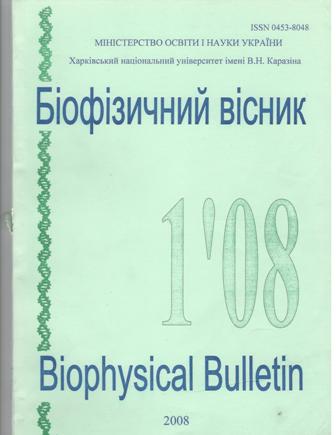Human erythrocytes resistance to haemolysis caused by polypeptide antibiotic gramicidin S
Abstract
Lytic activity of gramicidin S underlies its antimicrobial potential and at the same time restricts system clinical application of this polypeptide antibiotic. GS synthetic analogs are aimed at dissociating its antibacterial and hemolytic activity in a way that to dramatically diminishes the later effect. Structure-function relations in a rigid planar cyclic decapeptide molecule allow goal-seeking new preparations. Another key bit for a successful drug discovery policy is a clear understanding of the mechanism of GS interaction with cellular membranes. In the present paper with the help of turbidimetric technique the temperature and concentration dependence of GS-induced hemolysis has been studied. The activation energy of the human red blood cells hemolysis under the action of GS was estimated. It was shown that the analysis of the GS-induced hemolysis data allows gathering additional information on the state of membrane lipid bilayer if compared to conventional HCl-induced hemolysis.
Downloads
References
2. Гаузе Г.Ф. Грамицидин С и его применение. - М.: Б.и.. 1952. - 153 с.
3. Полин А.Н., Егоров Н.С. Структурно-функциональные особенности грамицидина С в связи с его антибиотической активностью // Антибиотики и химиотерапия. - 2003. - № 48(12). - С. 29-32.
4. Abraham Т., Marwaha S., Kobewka D.M. et al. The relationship between the binding to and permeabilization of phospholipid bilayer membranes by GS14dK4, a designed analog of the antimicrobial peptide gramicidin S // Biochim. Biophys. Acta. - 2007. V. 1768, N 9. - P. 2089-2098.
5. Kiricsi M., Prenner E.J., Jelokhani-Niaraki M., Lewis R.N.A.H., Hodges R.S.. McElhancy R.N. The effect of ring-size analog of the antimicrobial peptide gramicidin S on phospholipids bilayer model membranes and on the growth of Acholeplasma laidlawii В // Eur. J. Biochem. - 2002. - V. 269. P. 5911-5920
6. Prenner E.J.. Lewis R.N.A.H., McElaney R.N. The interaction of the antimicrobial peptide gramicidin S with lipid bilayer model and biological membranes // Biochimica et Biophysica Acta. - 1999. - V. 1462. - P. 210-221.
7. Биофизика клеточных популяций и надорганизменных систем: Сб.науч.тр. / Отв.ред. И.И. Гительзон. - Новосибирск: Наука, СО, 1992. - 159 с.
8. Przybylska M., Bryszewska М., Chapman I.V. Thermal properties and fluidity of human erythrocyte membranes in diabetes mellitus // Int. J. Radiat. Biol. - 1993. - V. 63, N 3. - P. 419-424.
9. Przybylska M., Bryszcwska M., Kedziora J. Thermosensitivity of red blood cells from Down's syndrome individuals // Bioelectrochemistry. - 2000. - V. 52. N 2. - P. 239-249.
10. Булгакова B.Г. Королев П.H., Петрыкина З.М. и др. Изменения оптической плотности суспензии протопластов бактерий подвергнутых действию мембрано-активных антибиотиков // Антибиотики. - 1984. - Т. 29, N 10. - С. 756-760.
Authors who publish with this journal agree to the following terms:
- Authors retain copyright and grant the journal right of first publication with the work simultaneously licensed under a Creative Commons Attribution License that allows others to share the work with an acknowledgement of the work's authorship and initial publication in this journal.
- Authors are able to enter into separate, additional contractual arrangements for the non-exclusive distribution of the journal's published version of the work (e.g., post it to an institutional repository or publish it in a book), with an acknowledgement of its initial publication in this journal.
- Authors are permitted and encouraged to post their work online (e.g., in institutional repositories or on their website) prior to and during the submission process, as it can lead to productive exchanges, as well as earlier and greater citation of published work (See The Effect of Open Access).





